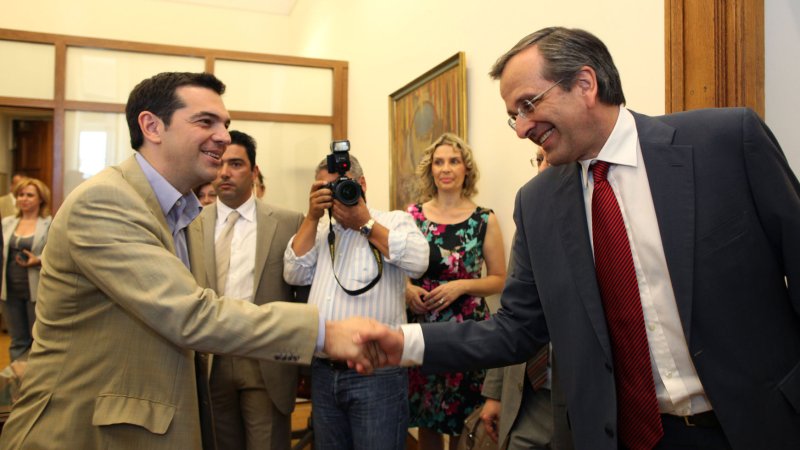Leader of the New Democracy conservative party Antonis Samaras, right, shakes hands with head of Greece's radical left-wing Syriza party Alexis Tsipras, at a meeting in the Greek parliament, in Athens, on Monday, June 18, 2012. Samaras, who came first in Sunday's national election, said he will meet with leaders of all parties "that believe in Greece's European orientation and the euro" this afternoon in order to form a new coalition government. UPI/Petros Giannakouris/Pool |
License Photo
Was that a boost provided to markets on the day after the elections in Greece reinforced the status quo?
If so, it was the hint of a boost or somewhere between a wink and a whisper. It wasn't much and that pallid optimism may continue for a while, as the troika, with or without a victory by left-leaning Syzira, has said it would renegotiate Greek loans with a greater appreciation for -- how to say this -- not strangling the borrower in the process.
Investors certainly did not yawn after the votes were tallied, but there certainly wasn't a clear indication of what was next.
In Washington, policymakers at the U.S. Federal Reserve are meeting Tuesday and Wednesday to answer that question as precisely as they can.
The danger, of course, is too much optimism. Fed officials have suggested there needs to be more for them to go on, besides a stalling recovery. Fed Chairman Ben Bernanke has said the telling factor that would push the Fed to make a move is the unemployment rate.
It is slipping and there is very little evidence to suggest the backsliding is a blip in the overall scheme of things. Although the unemployment rate retreated from more than 9 percent less than a year ago, there is evidence to suggest the improved unemployment rate is the anomaly, rather than the recent months in which the improvement stalled.
It's true, the number of jobs added to the economy jumped briefly from an average near 150,000 a month to more than 250,000, but more than 25 percent of the decline in the unemployment rate was still caused by people leaving the workforce. Most economists agree it takes nearly 325,000 new jobs per month to lower the unemployment rate.
The fundamentals behind the dropping unemployment rate are also less than reassuring. The trade deficit, specifically, narrowed in April to $50.1 billion, but don't celebrate just yet. In the greater scheme of things, that's like saying that the diet is going well because you are losing weight in between meals.
The Fed has few options that make any sense at this point. The central bank could extend "Operation Twist," which ends this month just as a gesture to show that something is being done. The New York Times pointed out the Fed could also announce that it expects to keep its zero to 0.25 percent lending rate beyond 2014, which is like saying "Teeth or no teeth, we'll keep serving soft food for as long as we have to."
In international markets Tuesday, the Nikkei 225 index in Japan fell 0.75 percent while the Shanghai composite index in China dropped 0.66 percent. The Hang Seng index in Hong Kong lost 0.06 percent while the Sensex in India rose 0.92 percent.
The S&P/ASX 200 in Australia slipped 0.33 percent.
In midday trading in Europe, the FTSE 100 index in Britain added 1.22 percent while the DAX 30 in Germany gained 0.88 percent. The CAC 40 in France rose 0.55 percent while the Stoxx Europe 600 climbed 0.92 percent.















